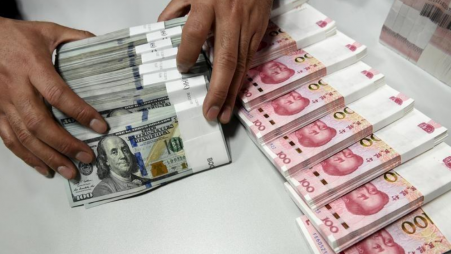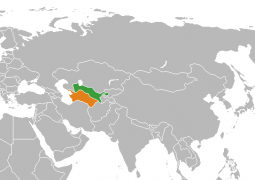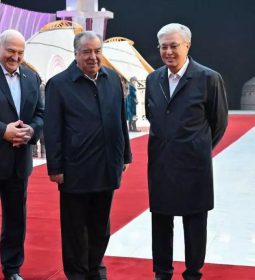Flushing economy with yuans: China plans to pump trillions into economy – with repercussions

China unexpectedly maintained a key interest rate, but analysts expect a lower growth target as banks face confusion.
China is set to unleash trillions of yuan of fiscal stimulus to revive an economy expected to shrink for the first time in four decades, while a planned growth target is likely to be cut, according to four policy sources.
The ramped-up spending will aim to spur infrastructure investment, backed by as much as 2.8 trillion yuan ($394bn) of local government special bonds, said the sources. The national budget deficit ratio could rise to record levels, they added.
In a surprise move on Friday, China kept its benchmark lending rate unchanged, defying expectations that it would ease borrowing costs as businesses face widespread disruptions from the coronavirus pandemic.
The one-year loan prime rate (LPR) was left unchanged at 4.05 percent from the previous monthly fixing while the five-year LPR remained at 4.75 percent.
Analysts said the unchanged rate suggests policymakers may think recent measures are enough to help the economy in the immediate term, after the central bank last week cut the amount of reserves commercial banks are required to hold.
But while the People’s Bank of China (PBOC) has rolled out powerful easing measures since the coronavirus outbreak, many economists said it was still not enough to revive demand in the current environment.
“The lack of any cut this month means that the LPR is still only 10 basis points lower than it was at the end of last year, following a small cut in February,” Julian Evans-Pritchard, senior China economist at Capital Economics said in a note.
“But with the economy unlikely to get back on track until next year, further monetary easing will be needed to help address the continued strain on corporate and households balance sheets.”
Beijing is likely to have to lower its economic growth target for 2020 given the prolonged effects of the pandemic, according to sources involved in internal policy discussions who declined to be named due to the sensitivity of the matter.
Chinese leaders are considering proposals from advisers to cut it to as low as 5 percent from the original target of about 6 percent agreed in December, they added.
The National Development and Reform Commission, the top state planner, the finance ministry and the central bank did not immediately respond to Reuters’ request for comment.
Sources said local governments will be allowed to issue more special bonds as the government aims to speed up the construction of planned key infrastructure projects as well as to launch some new projects for public health, emergency-materials supplies, 5G networks and data centres.
But Beijing faces constraints from rising debt levels and falling investment returns, following repeated stimulus efforts since the global financial crisis, when it unleashed an enormous spending package.
Higher government spending could push the 2020 budget deficit ratio to as high as 3.5 percent – up from last year’s 2.8 percent, the sources said.
Here’s the snag
China has already rolled out a series of fiscal and monetary measures to provide credit and tax relief to companies, especially small businesses that have borne the brunt of the outbreak.
But efforts to pump 800 billion yuan ($118bn) into companies via cheap bank loans to counter the economic impact of the virus outbreak have run into a snag: bureaucratic confusion.
Communication issues, confusing eligibility criteria and different lending standards have caused a muddle between officials over which companies qualify and at what rate, according to seven sources with direct knowledge of the situation.
That has left some banks at risk of future bad loans after offering finance to companies who turned out ineligible for subsidies, or holding loans which have already needed to be renegotiated.
Although China has frequently used lending along policy lines, these plans, announced as part of broader initiatives in January and again in February, represent the first time China’s central bank has coordinated rescue efforts with other government departments.
Under the first plan to channel 300 billion yuan ($42.36bn) of cheap loans to help with epidemic control, China-based firms were encouraged to apply to either the Ministry of Industry and Information Technology (MIIT), which typically deals with tech policies or the National Development and Reform Commission (NDRC), the country’s top state planner.
The two regulators circulated lists of eligible firms to banks, which could then lend the funds, safe in the knowledge they could reclaim the money from the People’s Bank of China (PBOC). The borrowing companies could then also claim half the interest payments back from the finance ministry.
But a breakdown of communication between the departments on loan standards means banks are left confused, said five bankers involved in the process.
Some banks have been left trying to unwind loans or raise agreed interest rates, said two bankers.
Others were told that lists from local MIIT and NDRC offices have been cancelled or that the central bank had tightened its lending criteria after lenders had already conducted their own due diligence, they added.
“Some banks already started negotiating with clients to rewind the interest rate back to a normal level of around 5 percent,” instead of an agreed subsidised rate about 1.6 percent, said one banker at a local lender in Shanghai.
MIIT, NDRC, PBOC and the Shanghai branch of PBOC did not respond to requests for comment.
Big state banks and smaller city lenders alike are under political pressure to lend – and they have been warned by financial regulators they will face unspecified repercussions if they do not do so, said one banker.
Still, those instructions are unclear.
“There’s nothing written down,” shrugged a Shanghai-based banker from a national lender. “It’s possible that the threat won’t materialise.”
- Previous Turkey sent 500,000 coronavirus test kits to United States
- Next Macron threatened travel ban on UK unless stringent measures enacted


![China plans to pump trillions into economy - with repercussions As Chinese citizens trickle back to work, banks and authorities have faced bureaucratic confusion in handing out new loans [File: Alex Plavevski/EPA]](https://www.aljazeera.com/mritems/imagecache/mbdxxlarge/mritems/Images/2020/2/3/50357dcdb4b14a35a4eeb02da2fc03b8_18.jpg)














